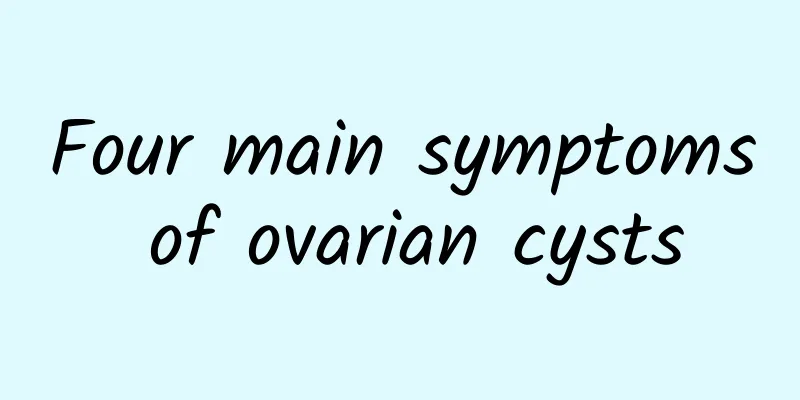What does a woman check for with ultrasound after an abortion? Four abnormal conditions that women should be alert to after an abortion

|
After a woman has an abortion, the doctor will tell her that she needs to have an ultrasound examination again. This makes most women wonder why they need to have an ultrasound examination, whether the abortion was not done cleanly, etc. In the following content, we will answer what the ultrasound examination after an abortion is to resolve everyone's doubts. What does B-ultrasound check after abortion? 1. Incomplete uterine aspiration: This is a common postoperative complication of artificial abortion, which refers to the residual uterine cavity of part of the embryo or chorionic villus tissue after abortion. Generally, if the postoperative bleeding lasts for more than 15 days or there is an early pregnancy reaction, it must be taken seriously. B-ultrasound and blood HCG can help to diagnose that a uterine curettage should be performed, and antibiotics should be used to prevent infection after the operation. 2. Infection: refers to gynecological inflammation within 2 weeks of abortion, first endometritis, which will affect the uterine myometrium, appendages, peritoneum, and even sepsis if not treated in time. It is often caused by incomplete uterine aspiration, prolonged bleeding, or premature sexual intercourse. It can also be caused by incomplete treatment of existing lesions in the body, or surgical infection. It is often manifested as lower abdominal pain, irregular bleeding, leucorrhea turbidity, and fever. Antibiotic treatment should be actively used. 3. Intrauterine hemorrhage: It often occurs in curettage with a late gestational age of more than 10 weeks. The uterus contracts poorly after surgery, and the blood clots in the uterine cavity are difficult to discharge and accumulate in the uterine cavity. Symptoms include abdominal pain, bleeding, enlarged uterus, high tension, and obvious tenderness after surgery. After diagnosis, a second suction is required immediately. Therefore, pregnancy should be discovered in time and terminated before 10 weeks as much as possible. During the operation, the cervix should be dilated routinely to prevent the cervix from being too tight after surgery, which is not conducive to the outflow of blood in the uterine cavity. 4. Cervical or intrauterine adhesions: Amenorrhea or significantly reduced menstrual volume after artificial abortion, sometimes accompanied by periodic lower abdominal pain, no menstruation after artificial cycle treatment, or uterine enlargement and blood accumulation, cervical or intrauterine adhesions should be considered. Repeated artificial abortions or curettage, especially when accompanied by infection, are more likely to occur. If it is cervical adhesion, the old blood will be discharged after dilation of the uterus, and it will be significantly improved. If it is intrauterine adhesion, it is necessary to separate the adhesions under hysteroscopy, place an intrauterine contraceptive device after surgery, and take estrogen to prevent adhesions again. Abortion is very harmful to women's body. Therefore, B-ultrasound examination must be carried out on time after abortion to detect the above situation in time and actively cooperate with the doctor for treatment. In addition, women are weak after abortion and must pay more attention to rest to avoid sequelae. What are the precautions after abortion? 1. Pay attention to rest and strengthen nutrition: You should rest in bed for 2-3 days after the abortion, and then you can get out of bed and move around, gradually increasing the activity time. Do not engage in heavy physical labor or cold water labor within half a month after the abortion to avoid catching cold. Pay attention to increasing nutrition, eat more protein-rich foods such as fish, meat, eggs, bean products, and fresh vegetables rich in vitamins to promote the repair of the endometrium. 2. Keep the vulva clean and strictly prohibit sexual intercourse: After the abortion, the cervix has not yet completely closed, and the endometrium also has a process of repair. During this period, special attention should be paid to keeping the vulva clean and hygienic. The sanitary napkins and underwear used should be washed and changed frequently. Do not sit in the bath within half a month after the operation to prevent dirty water from entering the vagina and causing infection. If you have sexual intercourse too early after the abortion, it is easy to cause acute endometritis, pelvic inflammatory disease, and secondary infertility. Therefore, sexual intercourse is strictly prohibited within one month after the abortion. 3. Observe the bleeding situation: If vaginal bleeding lasts for more than 7 days after abortion, and is accompanied by abnormal conditions such as turbid and smelly leucorrhea, lower abdominal pain, fever, etc., you should go to the hospital for a follow-up visit in time. 4. Insist on contraception: After abortion, the functions of the ovaries and uterus gradually recover, and the ovaries ovulate on schedule. If you do not insist on contraception, you will get pregnant again soon. Therefore, after abortion, you should choose reliable contraceptive measures as soon as possible, and you must insist on contraception as the main method. You cannot use abortion as a contraceptive measure. The recovery time after abortion is generally 3-7 days. The amount of bleeding does not exceed the amount of previous menstruation, and there are generally no blood clots. There is a slight lower abdominal pain on the day of abortion, which gradually disappears or occasionally occurs. If you feel heavy bleeding or discomfort, it is recommended to go for a check-up in a week. In addition, if you cannot take good care of your body after abortion, various gynecological diseases will come to you, which will have a great negative impact on future fertility. Therefore, you must pay more attention to your daily living habits after abortion. |
<<: What kind of exercise can women do after abortion? Women can try these exercises after abortion.
Recommend
Can irregular menstruation be treated?
Can irregular menstruation be treated? Menstruati...
What are the effects of cervical warts on pregnant women?
Cervical warts are contagious and can cause serio...
Can women have sex during menstruation? What are the taboos during menstruation?
In this fast-developing society, people are overw...
There are growths on the inner wall of the labia majora. Bacterial vaginosis was detected last month.
There are growths on the inner wall of the labia ...
The most common symptoms of cervicitis
Among gynecological inflammatory diseases, I beli...
How to treat functional uterine bleeding
Functional uterine bleeding requires a suitable t...
What are the symptoms of endometriosis
Endometriosis is a common gynecological disease w...
Is it serious to have a malignant ovarian cyst?
Ovarian cysts are a very common female disease, a...
Doctors recommend 4 treatments for adenomyosis
What is adenomyosis? Adenomyosis is a common gyne...
Can I eat fruit after a miscarriage?
Spontaneous abortion refers to non-artificial abo...
What are the early symptoms of vaginitis?
Vaginitis brings a lot of unspeakable pain to our...
What should be checked for amenorrhea
Amenorrhea requires examination of hormone levels...
What are the hazards of uterine fluid to fertility?
Women will face many gynecological problems in th...
Does cervical warts affect pregnancy?
Many people do not know the harm of cervical wart...
Can Bartholinitis be spread through saliva?
Only by correctly analyzing the causes of Barthol...









